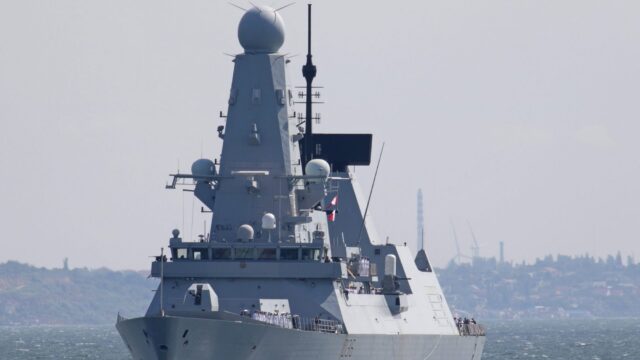By Drones, Mines and Missiles — The British Naval War Against Russia in Ukraine

Since at least 2014 The United Kingdom has been a major participant in NATO’s proxy war against Russia. During the hot phase of the war it has directed a drone and missile campaign in the Black Sea. It is likely responsible for current attacks against Russia related sea transport. It is developing new naval drones for further assaults on Russia.
Britain had initiated and run massive public relation campaigns blaming Russia for various outrages which, in fact, never had happened. Consider the Skripal Affair, the MI6’s Steele dossier used to launch Russiagate and other operations launched through the anti-Russian Integrity Initiative run by the UK government’s Institute of Statecraft.
It was the Brits who, during the war in Ukraine, directed the Black Sea Attack Network (BSAN) to push the Russian fleet out of Sevastopol in Crimea. British Storm Shadow missile were fired against various ships. Directed by British signal intelligence seagoing drones, made in Britain, attacked Russian transports as well as the Kerch Bridge.
As the Armchair Warlord explained:
The BSAN sea drone program scored a number of successes and hair-raising near-misses over the course of 2023 and early 2024, most notably sinking the Tarantul-class missile boat Ivanovets with what was likely some loss of life on February 1st, 2024. At that point I suspect that the Russian Navy decided that something had to be done and, having carefully studied their foe, put a plan into action to destroy what was to them the most concerning part of the BSAN – the maritime drone program.
Using a few rusty old ships as bait the Russian command observed the signal activities during Ukrainian attacks, uncovered the British run network, and finally killed it:
Deployed without support in the Kerch Strait during a large-scale (albeit unsuccessful) aerial drone raid, the Kotov attracted the attention of Ukrainian sea drones heading for another round with the Kerch Bridge. Video from the battle again suggests only a modest defensive effort with small arms, with subsequent reports that the ship was abandoned quickly (with few to no Russian casualties) and basically allowed to sink. It’s noteworthy that the remaining drones were, again, easily mopped up by rescuers. And here, after this engagement, the Black Sea Attack Network was undone.
You see, congratulations were in order. Zelensky wanted to personally pin medals on the men who were destroying the hated Russian Black Sea Fleet. So, two days later, the personnel of the Black Sea Attack Network – the drone operators, the planners, the technicians, the officers, bosses and bosses’ bosses, and likely a gaggle of foreign advisors – assembled in a hangar in Odessa to receive accolades from their nation’s leader. Zelensky arrived (with the Greek Prime Minister in tow, apparently, perhaps sending a message to a significant maritime player), pinned medals on chests, shook hands, and departed.
His motorcade was a block away when a Russian Iskander ballistic missile sliced through that hangar’s roof and wiped out the assembled personnel of the Ukrainian sea drone network. It was probably launched the instant he walked out the door.
There were reports of a large number of NATO helicopters flying into Odessa in the strike’s aftermath, and shrieking from the usual suspects that the Russians had “tried” to assassinate Zelensky, as though they couldn’t kill him any time they wanted. Meanwhile, the Russian MoD put out a dry statement that they’d struck a target in Odessa associated with the Ukrainian drone campaign.
There have been no noticeable Black Sea sea drone attacks since.
There is however a new maritime campaign under way against all ships, not only Russian ones, which have recently visited Russian ports:
A spate of blasts recorded across the Mediterranean on tankers that have recently called at Russian ports has security analysts concerned about a new form of attack targeting merchant shipping.
Two Thenamaris aframax tankers – the Seajewel and the Seacharm – have both reported explosions onboard in the past month in the Mediterranean, while the Grace Ferrum product tanker has also been badly hit off Libya, all suffering similar damage – holes in hulls below the waterline, leading to some security analysts to suggest the vessels were targeted with limpet mines.
In late December, the Russian Ursa Major general cargo ship sank in the Mediterranean between Spain and Algeria after an explosion.
Away from the Mediterranean, the Turkish-owned Koala tanker, laden with 130,000 tonnes of heavy fuel oil, was about to set off from the Russian port of Ust-Luga when three explosions ripped through the rear of the ship on February 9, forcing the crew to evacuate.
Those are five ships so far that have been sunk or damaged by limpet mines attached to the ships after they had visited Russian ports. This is an intimidation campaign to deter ship owners and operators from servicing anything Russian.
I doubt that the Ukrainian military intelligence, the GRU under the terrorist General Budanov, has the network and divers needed to attack Russia related shipping throughout the Mediterranean. The Brits though, through their various commercial and military activities – ship classification societies, ship insurances, crewing agencies etc. – do have the necessary information and access to ports.
That is why I suspect them to be deeply involved in the current campaign.
More naval warfare will be coming as a new British sea-drone campaign is about to commence:
New British naval drones in testing for Ukraine, ukdj, Feb 6 2025
The Ministry of Defence is putting two newly developed uncrewed maritime systems—Snapper and Wasp—through final testing.
During a Written Question session on 30 January 2025, Luke Akehurst (Labour – North Durham) asked about progress on both systems, referencing remarks from the Defence Secretary’s speech at the ADS Annual Dinner on 28 January 2025.
In response, Maria Eagle, Minister of State at the Ministry of Defence, stated that both Snapper and Wasp are “new uncrewed maritime system[s], which [have] been rapidly developed specifically to support Ukraine.” She added that “The system is currently undergoing final testing and further details will be set out in due course.”
A third British sea-drone system is still under development:
Recently, we reported that the Ministry of Defence (MOD) had announced a Project COOKSON Challenge Session back in January. The event invited industry partners from NATO, Ukraine, and Five-Eyes countries to help shape the development of a versatile, fast, and low-observable maritime system designed for operations in Ukraine and beyond.
…
The MOD described the system as follows:“A COOKSON system consists of a small, fast, vessel with low observability, with >2 one-way effectors mounted on it, including relevant launch system and support equipment. A COOKSON system should be able to travel to Ukraine via Ground Lines of Communication (GLOC) [and] must fit onto a 40 foot flatbed, ideally a 20 foot flatbed.”
The Snapper and Wasp sea-going drones may appear in the Black Sea within the next few months. Cookson systems will still take a year to be ready for action.
From their work against the first wave of Black Sea drones the Russian naval forces have learned that it is more efficient to destroy the network behind a series of attacks than to defend against each of them.
One wonders how deeply the British Ministry of Defense has thought about that.
